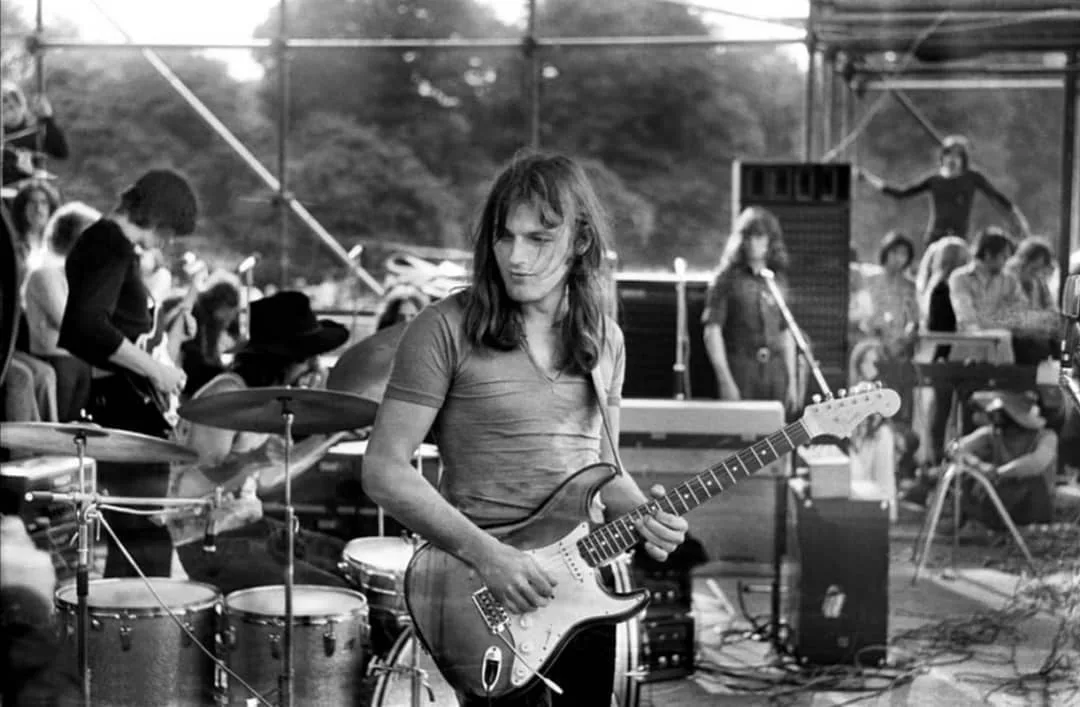Gilmour's flagship tones
David Gilmour’s guitar tone is as iconic as the music of Pink Floyd itself—soulful, soaring, and steeped in spacious texture. In this article we will attempt to take you on a deep dive through the amp and effects chain behind some of Gilmour’s most legendary sounds—from Meddle to The Wall—and show how to approximate them with gear you can actually find on our website musicpower.gr today. As always, we’re not claiming to exactly replicate Gilmour’s famously elaborate rig. Pink Floyd were, after all, one of the biggest bands in the world, using some of the best studios, engineers, and custom gear in music history. But with the help of research and a few well-chosen pedals, we can get close to the spirit of those tones—whether it’s fuzzed-out sustain, swirling modulation, or cosmic delay. Backle up, our journey begins.
1. The Lead Tone Formula
F² + D² = S² (Fuzz + Delay = Sustain for Days)
The equation F² + D² = S² humorously yet aptly captures the magic of electric guitar tone: Fuzz squared plus Delay squared equals Epic Sustain squared—a tone that never fades, but floats endlessly in the air like an electric dream. This “equation” may not be mathematically strict, but it’s sonically spot-on: when the richness of fuzz and the echoes of delay are perfectly blended, they create a sound so full and enduring, it feels like it could last forever.
To get that iconic solo tone from “Echoes,” we paired an Analogman BC108 Sun Face (Gilmour’s preferred silicon Fuzz Face style) with a T-Rex Binson Echorec—a modern version of the magnetic disc delay unit Gilmour used to create swirling, rhythmic echoes. Through a Hi-Tone amp based on his modded Hiwatt, the result is that unmistakable soaring sustain.
Your options:
Fuzz: DUNLOP FFM1 Silicon Fuzz Face Mini
Delay: BOSS RE-2 Space Echo, MXR M169 Carbon Copy Analog Delay
2. Modulated Clean Tones
Clean tones with modulation effects (such as chorus, tremolo, or phaser) add movement and depth to the sound without compromising its clarity. A clean signal, enriched with a gentle modulation waveform, takes on an almost “liquid” character — as if it’s breathing within the space. Ideal for atmospheric passages, arpeggios, or dream-pop soundscapes, this combination produces a tone that is both crystalline and magically fluid.
One of the most distinctive elements of David Gilmour’s sound is his clean, shimmering tones with rich modulation — perfect for arpeggios and ambient passages. To capture that vibe, we used an MXR M68 UniVibe Chorus – Vibrato for subtle stereo chorus and an MXR M101 Phase 90 for airy, swirling phasing. When paired with a clean amp like a Hiwatt-style head or a high-headroom combo, the result is the signature “liquid” clean tone heard in tracks like “Shine On You Crazy Diamond” and “Breathe.”
3. Happy Accidents: The Backwards Wah Connection
Have you ever plugged your cables in the wrong way? Well, David Gilmour did — on purpose. When you connect a wah-wah pedal backwards, it doesn’t work as intended, and the result is entirely unpredictable. Instead of the familiar sweeping filter effect, the pedal may produce a broken, muted, or even completely silent sound, depending on its internal circuitry. In some cases, weird phase interactions and glitchy behavior can emerge — effects that, while unintended, can be artistically interesting, especially in noise or experimental music. It’s not designed for this kind of use, but it can become a tool for sonic exploration, unlocking tones that exist outside the conventional signal chain.
By reversing the signal path through a Wah pedal, Gilmour created a wild, howling effect famously used in “Echoes.” This is a perfect example of how some of the most iconic sounds come purely from experimentation. The backwards Wah didn’t behave like a traditional filter — instead, it produced an aggressive, vocal-like scream, adding raw texture and unpredictability to the tone. It’s a reminder that breaking the rules and pushing gear beyond its intended use can lead to uniquely expressive sonic moments.
Your Wah options:
4. Delay Magic
The magic of delay is more than just repeating the signal — it’s how sound gains depth, emotion, and a sense of space. From subtle shadows behind each note to pulsating walls of echoes that build entire sonic landscapes, delay transforms playing into an experience. Whether it’s a short rockabilly-style slapback or endless ambient trails, delay pedals add that “something extra” that makes each phrase linger just a bit longer than the note itself — as if it refuses to fade away.
By the The Wall era, Gilmour had fully embraced digital delay and precise layering. “Run Like Hell” features galloping riffs filtered through a Boss DD-3-style delay, Electric Mistress flanger, and light compression from an MXR M102 DynaComp. The echoes don’t just repeat — they become part of the music itself. Gilmour’s gear is legendary, but his true signature lies in the feel. It’s not just what’s on the pedalboard — it’s how you play through it.
Explore our collection of guitar effects at musicpower.gr and discover your own version of these iconic tones. And remember: the most important thing is to experiment and explore. That’s why you’ll find a huge variety of guitar pedals at our physical store in Katerini, at 41 Terzopoulou Street. Come try them out — we’d love to share this unique experience with you.







